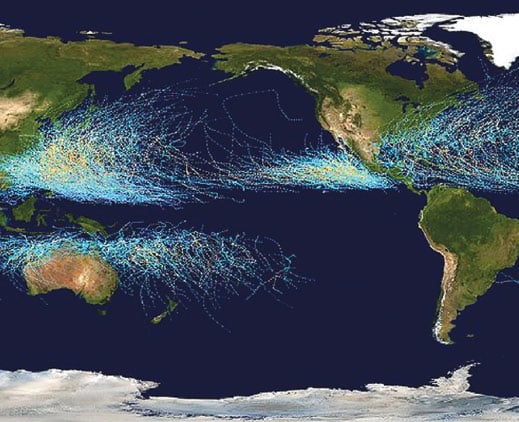Powerful, destructive tropical cyclones are reaching their peak intensity farther from the equator and closer to the poles, according to a study coauthored by an MIT scientist.

The study, published in Nature, shows that over the last 30 years, tropical cyclones—also known as hurricanes or typhoons—have been moving poleward at a rate of about 33 miles per decade in the Northern Hemisphere and 38 miles per decade in the Southern Hemisphere.
“The absolute value of the latitudes at which these storms reach their maximum intensity seems to be increasing over time in most places,” says Kerry Emanuel ’76, PhD ’78, an MIT atmospheric scientist and coauthor of the new paper with Gabriel A. Vecchi of the National Oceanic and Atmospheric Administration (NOAA) and lead author James P. Kossin of NOAA’s National Climatic Data Center.
And while the atmospheric mechanisms behind this change are still being investigated, the trend seems consistent with a warming climate. “It may mean the thermodynamically favorable conditions for these storms are migrating poleward,” adds Emanuel. In other words, fewer fierce storms are peaking in the tropics, possibly because conditions there are becoming too hot.
The implications are serious, since the movement of peak intensity means some regions may now have greater exposure to these extreme weather events, leading to “potentially profound consequences to life and property,” the paper states.
To conduct the study, the scientists used international data from 1982 to 2012, collected by NOAA. They used the location of peak intensity of a cyclone as the benchmark because it is a more consistent metric than statistics such as storm duration.
While there are regional differences in the poleward movement of cyclones, with only a modest change in the Atlantic Ocean, the paper notes that every ocean basin other than the northern Indian Ocean has experienced this change and suggests that “migration away from the tropics is a global phenomenon.”
However, Emanuel notes, the global mechanisms underlying the trend require further research. He thinks the cyclone trend is connected to the poleward movement of the Hadley circulation, a large-scale pattern of global winds.
Emanuel notes that researchers are continuing to examine the links between storm migration and global warming. Ocean temperatures between 82 and 86 °F occur in a belt of tropical water that is “ideal for the genesis of … cyclones,” Emanuel says. He adds, “As that belt migrates poleward, which surely it must as the whole ocean warms, the tropical cyclone genesis regions might just move with it. But we have more work to do to nail it down.”
Keep Reading
Most Popular
Large language models can do jaw-dropping things. But nobody knows exactly why.
And that's a problem. Figuring it out is one of the biggest scientific puzzles of our time and a crucial step towards controlling more powerful future models.
How scientists traced a mysterious covid case back to six toilets
When wastewater surveillance turns into a hunt for a single infected individual, the ethics get tricky.
The problem with plug-in hybrids? Their drivers.
Plug-in hybrids are often sold as a transition to EVs, but new data from Europe shows we’re still underestimating the emissions they produce.
Stay connected
Get the latest updates from
MIT Technology Review
Discover special offers, top stories, upcoming events, and more.